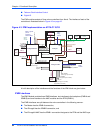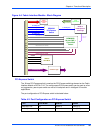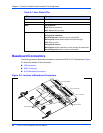
Chapter 4 Functional Description
ATCA-C110/1G Installation and Use Manual
49
REVIEW COPY
Serial ATA interface
The Serial ATA (SATA) interface is a high-speed serialized storage interface. The 2x SATA
interface from the AMC Connectors are routed through the AMC interconnect to the
ATCA-C110/1G’s SATA Multiplexer on the Fabric Interface Module.
Gigabit Ethernet - SerDes Interface
The ATCA-C110/1G incorporates an onboard Gigabit Ethernet Switch on the Fabric Interface
Module. The Gigabit Ethernet Switch provides node connections to the Base Interface, Fabric
Interface, Ethernet connections to the AMC bays, Processor and the ARTM-C110. The Base
Interface (10/100/1000 BASE-T Ethernet) from the ATCA backplane is converted to the SerDes
interface by the GbE transceiver.
The Fabric Interface is above the Physical layer of the Ethernet and is a SerDes interface. The
following interfaces and signals are routed to the FIM:
■ Gigabit Ethernet interface connections on the ATCA-C110/1G board
■ SerDes signals from each of the AMC Bays
10/100 Ethernet
The MPC8540 integrates a Fast Ethernet Controller. This interface is used on the
ATCA-C110/1G as a general purpose Fast Ethernet interface.The Fast Ethernet Transceiver
from Intel is used as the transceiver.
The output of the transceiver is routed to the RJ45 connector on the rear panel of the
ARTM-C110 through the Zone 3 interface.
The Management Interfaces of the Three Speed Ethernet Controllers (TSEC) and the Fast
Ethernet Controller are connected to the Ethernet Controller of the MPC8540, sharing a
common Management Controller. The Phy addresses of the respective devices are listed in
Table 6-10 on page 82.
Serial interface
The MPC8540 integrates two RS-232 serial port interfaces.
■ Serial Port 1 of the Processor is used for the communication between the Processor and
the IPMC.
■ Serial Port 0 is used as a general purpose/debug serial port and is routed to the RTM of
ATCA-C110/1G using the DB9 connector.
Serial Port 2 is equipped with RS-232 line drivers and are used in a 3-wire null-modem
configuration, without any modem control/status signals.


















